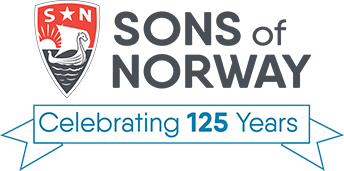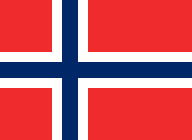Cultural Activities
Jotunheimen Lodge is involved in a wide variety of special events throughout the year featuring both traditional and contemporary programs with a unique Norwegian / American flavor. Members have the opportunity to participate in:
Hardanger Embroidery
Hardanger or “Hardangersøm” is a form of embroidery traditionally worked with white thread on white even-weave cloth, using counted thread and drawn thread work techniques. It is sometimes called whitework embroidery.
Hardanger embroidery uses satin stitch blocks known as Kloster blocks, consisting of 5 parallel satin stitches, worked over a group of 4 x 4 ground threads. These blocks enclose areas of fabric where a number of warp and weft threads are cut and withdrawn, leaving a network of loose threads and large holes within the shape defined by the Kloster blocks. Various decorative filling stitches are then worked over the remaining loose threads and holes to create a lacy effect.
The traditional style of Hardanger work is very geometrical in form and based on several basic shapes such as squares, rectangles, triangles, diamonds, hearts, zig-zags and crosses. The combination and placement of these elements allow an unlimited number of beautiful patterns of all sizes to be created.
Stitchery group includes all needle crafts with emphasis on cross stitch, knit, and crochet.
Special thanks to this website.
Acanthus Style Carving
The Norwegian Acanthus Style of carving has its roots in the Baroque and Rococo styles of mainland Europe. In the Early 1700’s these styles came to Norway through the Christian church and were carved in stone on church buildings. The style changed and over time became a popular form to carve in wood. Within a few decades Norway had achieved its own distinct style of woodcarving as a variation of the mainland European styles. As a country that has a long history of woodworking, Norwegians took to this new form of art in an enthusiastic way. Anything that could be carved was carved, including daily utensils, beds, furniture, insides and outsides of buildings, and personal items. Throughout the world this new style became known as the Norwegian Style of Acanthus woodcarving. In the mid 1800’s this woodcarving style was modified into a painting form that now is known as Rosemaling.
Special thanks to this website.
Rosemaling Classes
Rosemaling (Norwegian for rose painting) is the name of a form of decorative folk art that originated in the rural valleys of Norway. Rosemaling is a style of decorative painting on wood that uses stylized flower ornamentation, scrollwork and geometric elements in flowing patterns.
Each piece of rosemaling is by its very nature, an original, painted in the coloring and technique of the Norse folk-artists of a century ago. and finished with layers of lacquers.
Special thanks to this website.
Leikarringen Folk Dancing
The history of Norwegian folk dance is a rich heritage. Early dance in Norway consisted of song dances. The song was the accompaniment to the dance and told the stories of heroes and the other worldly. With the arrival of musical instruments in the 18th century, the song dance began to decline. Influences from Europe brought new ideas in music and dancing. Couples danced the polka and waltz. The accordion, flute and zither engrained themselves in the culture along with the movements meant to be companion to them.Folk dances in Norway are influenced regionally. Like a tartan, every area has signature dances as well as its own costume, called bunad. Each village might have its own version of dance to any given song. Formerly, only locals knew their own dances. Thanks to the oral and written record of the dances, most village dances are known across the country.
Jubileers Norwegian Chorale
Music based on traditional Norwegian form usually includes minor or modal scales (sometimes mixed with major scales), making a sober and haunting sound. Prior to the 18th century, there is scant written record of what kind of music was played in Norway, but there is a large aural tradition. In 1380, Norway had come under Danish rule, and thus had no royal house or nobility of its own; as a result, for 450 years, Norway did not participate as much in the musical development which occurred in royal (or “cultured”) circles throughout the rest of Europe. Religious and traditional (folk) music were dominant throughout this era in rural areas, though again scant records exist to document their nature. In the last half of the 20th century, Norway, like many other countries in the world, underwent a roots revival that saw indigenous music being revived.
Special thanks to this website.
Chip Carving
Chip carving has become for the woodworker an art form complete in itself. This technique uses triangular shaped cuts that create intricate and intriguing designs dancing across the surface of the wood. Patterns for chip carving are defined by a few basic elements, as the triangle or free form line, yet by varying the size and position of these elements new patterns are created.
Norwegian Cuisine
Norwegian cuisine in its traditional form is based largely on the raw materials readily available in Norway and its mountains, wilderness and coast. It differs in many respects from its continental counterparts with a stronger focus on game and fish.
Special thanks to this website.
Bjørnetann Language & Cultural Camp
Are you looking for an opportunity to expose your kids or grandkids to a fun Norwegian experience? Or perhaps you would like to come (without kids) and enjoy a few days of Norwegian crafts, language, cooking and fellowship? Bjørnetann Language and Cultural Camp is held each July at Luccock Camp near Livingston, Montana.
Camp experience includes: Norwegian language classes, folk dancing, folk songs, and wonderful Norwegian food will be enjoyed by all. You can learn woodcarving, rosemaling, yam carving, and more!
Please contact us for dates and more information on this year’s camp!
Open to Sons of Norway District IV members and their children and grandchildren.
Genealogy
Trace your Norwegian ancestors!
Participation in Community Events
. . . and much more!

